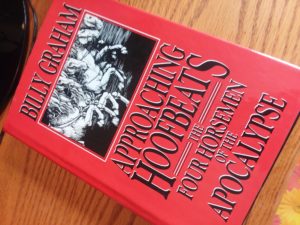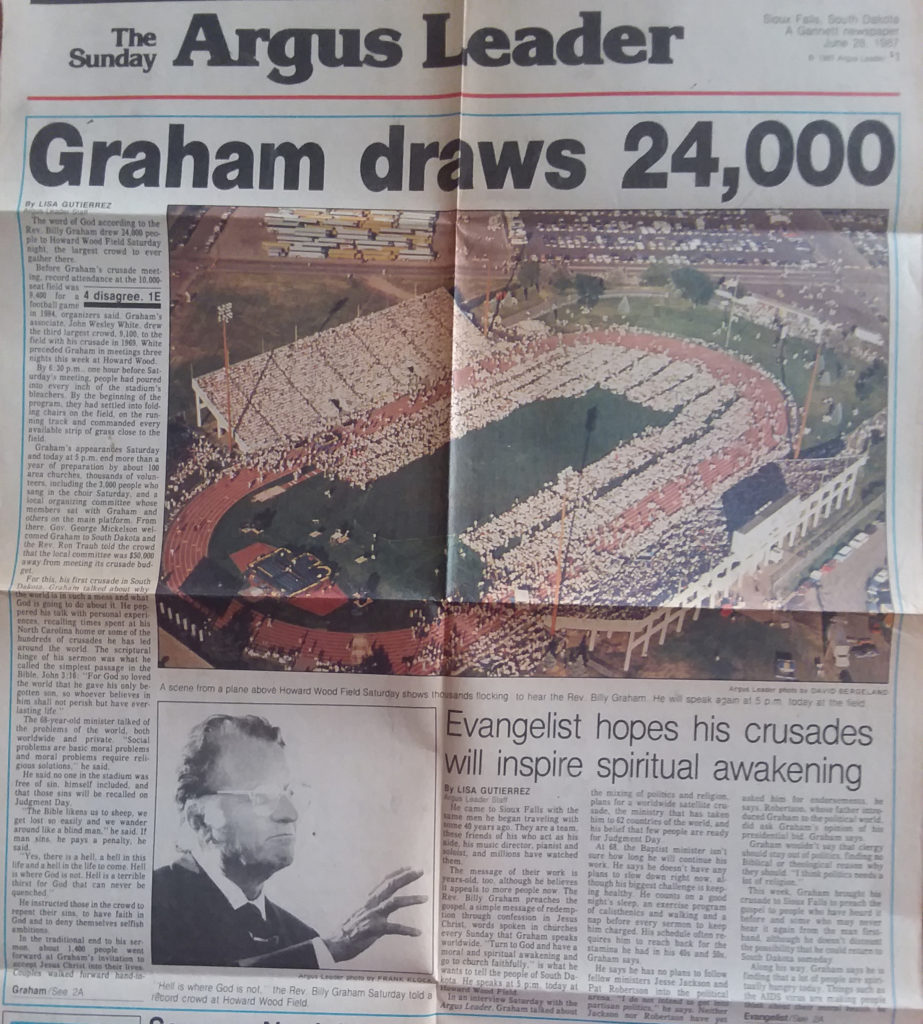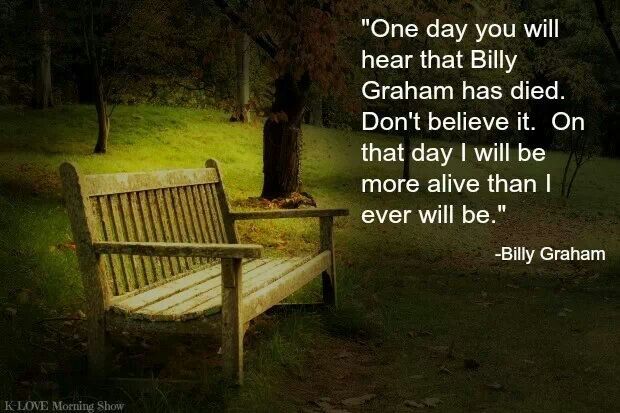I once met Billy Graham.
That’s probably not a unique statement. With all of the crusades or revivals he held in his lifetime and the millions of people who attended them, there must be thousands of people who can say, “I once met Billy Graham.”
With his death announced yesterday, however, I played through that meeting once again, perhaps more thoroughly than I have the hundreds of times I have personally reviewed it in my mind over the past 30 years.
I was working as press secretary to South Dakota Gov. George S. Mickelson. As the Graham crusade organizers were putting together the logistics for the visit to Sioux Falls, Gov. Mickelson was called upon to issue welcoming remarks to Dr. Graham and the thousands of attendees on the first night that the crusader spoke. That was June, 1987.
We were still young in that administration (about three months) so I’m not as certain what the governor’s initial response was to the invite as I might have been even six months later. But as the date approached and I heard that the event was on the calendar, I asked if I might tag along.
I was curious. I had grown up kind of put off by the fact that my favorite television shows, even those back in the days when most television was in black and white, were pre-empted by one of the Graham crusades. As a kid, I’d watch a little bit and gawk at those who tearfully made their way forward for altar calls. For some reason, we regularly received in the mail the “Decision” magazine which, I believe, was produced by the Graham association. I think my older brother might have expressed an interest in it at one time and once the family got on the mailing list, well, we were on the mailing list forever. Ours was a United Presbyterian family, at least from the time I was baptized. That was the old “northern” church that came about when the Presbyterians split over abolition and other such issues. I suspect it was a reasonable settlement between my mom’s Congregational background and my dad’s Dutch Reformed (with a hint of Jewish) heritage. Most importantly, though, the Presbyterians would have presented a sedate, stoic, upper-class image that my dad would have thought was appropriate for his business. There was no arm waving in the Presbyterian church. No altar calls. We knew there was a Holy Ghost, but he only made appearances on Pentecost Sunday and few recognized him. Dad seldom went to church, and when he did, he was snoring by the time the sermon started. I, on the other hand, loved church until I didn’t. That was some time in high school. I didn’t get back to church on a regular basis until after Terry and I got married which was 12 years later.
In the state plane going from Pierre to Sioux Falls that afternoon were the governor as well as Lt. Governor Walt Miller and his wife Mary, myself, and my husband Terry who the governor graciously invited to join us. From the time we landed, we were met by what we came to know as one of the most well-oiled rallying machines in our lifetimes. I’ve experienced presidential campaigns and presidential appearances that could have taken lessons from the Graham people.

 Billy Graham autographed my copy of “Approaching Hoofbeats.” He wrote simply. “God bless you. Billy Graham.”
Billy Graham autographed my copy of “Approaching Hoofbeats.” He wrote simply. “God bless you. Billy Graham.”
Now, in those days, traveling with the South Dakota governor usually meant picking up a car at the business side of the airport, climbing in, and, as Gov. Mickelson insisted, he drove. These were no rental cars either. They were usually cars that had been seized in some kind of drug bust or other legal obfuscation. Nor were they recent models. We could usually count on them to get us from point to point, but they would not have drawn any attention to their inhabitants. If the governor required some sort of official escort, local law enforcement or a member of the area highway patrol would pick him up and take him where he needed to go. He had no secret service.
On the day we arrived for the crusade, I recall several black cars (not limos), spit-shined, awaiting us as we de-planed. As I recall, Lt. Gov. Miller and his wife rode in one of those. Terry and I rode with the governor in another. Both cars were driven by members of the Graham staff who did resemble secret service. Our two cars were escorted by the highway patrol at front and back and as we approached each intersection, traffic was held so that we never had to stop for a light or wait to make a turn. It wasn’t so much that anyone was, in the eyes of a South Dakota public, so important in that group, but rather that the traffic was so heavy heading to the crusade that the way had to be cleared so that the governor could arrive in time to make his welcoming remarks.

I found this clipping from the front page of the Sioux Falls Leader inside the book that Billy Graham autographed for me in 1987. The paper chronicles his visit to the city.
We zipped into the city’s Howard Wood Field area and right up as close to the stadium as could be easily handled. Our doors were flung open by Graham staff and volunteers who promptly escorted us into what would today be called a “green room,” I suppose, but really was a nicely reimagined living room setting on the vast concrete beneath the bleachers at the west end of the field. There, creatively cordoned off from the rest of the area was a section with green plants, comfortable living room furniture, a large rug, and a long coffee table resplendent in fruits and cheeses. I believe water was the beverage of the day.
Dr. Graham was front and center, welcoming us and inviting us to be seated as if we were guests in his home. He was very friendly but not obsequious or overly eager. In fact, he was calm. Very reserved. As I have sat in our library over the years and gazed upon one of his books, the overwhelming feeling I have from that visit was the calm I felt from him. Considering the absolute fervent delivery of his messages, I did not expect calm in the midst of that tempest.
Before leaving home, I had put into a large purse a copy of one of his many books, “Approaching Hoofbeats, The Four Horsemen of the Apocalypse.” A Korean friend of ours from the Presbyterian Church in Pierre had given it to me. She has the heart of an evangelist and she so wanted me to dig deeper into my faith so she would nudge me along with any ploy she could conjure up. She hadn’t been very successful on that count as I figured I was about as deep as I wanted to be. Nonetheless, I had read the book and I brought it along in hopes of getting Dr. Graham’s autograph.
So there we were, just the six of us. And you would think with two politicians and a preacher in the room that the conversation would be lively. It wasn’t. Whatever was said fell completely upon Dr. Graham. I sat there getting increasingly uncomfortable.
I knew that Gov. Mickelson would have some hesitance about dealing with any religious-type. It wasn’t that he didn’t believe. He was raised in a United Methodist household and he often told the story of how his mother would pin Bible verses to the drapes at eye level for each of her children. As they were getting ready for church, each of the kids had to memorize whatever verse was before him or her. As his press secretary, I kept a Bible on the corner of my desk because he would sometimes ask me to find a passage he was thinking about but needed to know exactly the context. Yet, he had grown increasingly disenchanted with the church and he had led me to believe that preachers either talked too much politics from the pulpit or were always asking for money. He just didn’t want to be part of that.
Lt. Gov. Miller, however, I knew to be an evangelical. I fully expected him to be fully engaged in conversation with Dr. Graham. But he said very little. Mrs. Miller said nothing.
As for Terry, he was just hoping to get a glimpse of George Beverly Shea as he wanted to get Shea’s autograph on his sheet music for “How Great Thou Art” which bore Shea’s picture. He did get that accomplished.
And from my standpoint, I had come into that position of press secretary believing I should be seen and not heard. It was my aim for my entire term in that position to spend little if any time in front of cameras and microphones. My work was in the background. So I didn’t say anything either.
Finally, to break the unease, Dr. Graham leaned over and pointed to the great healthy repast on the coffee table and asked us if we would like to help ourselves. No one did. Gov. Mickelson did offer to serve Dr. Graham, but Graham said (and I’ll never forget this as I have put it to use so many times since my life changed and I became a Presbyterian minister – yes, I did have to go deeper), “No, thank you. I learned a long time ago never to eat before speaking publicly.”

George Beverly Shea autographed Terry’s copy of “How Great Thou Art.” That’s Shea’s picture on the cover. He was a lot older than that when we saw him in 1987. Terry has played this on his horns several times in churches and has always used this music.
I suppose it was only a few minutes but it seemed like an hour had passed before we were all given the heads up to begin our movement outside. It was only then that I pulled out my book and as Dr. Graham brought up the rear of our little band, I turned to him and quietly asked him if he would mind autographing it for me. He did seem honestly surprised. “Have you read it?” he asked, looking straight at me. “Yes,” I replied simply, and smiled. He penned, “God bless you. Billy Graham,” on the opening page. I thanked him, stashed the book in my purse, and we headed on out where I was aghast to find that Terry and I were not only seated on the dais with all of the muckety-mucks, but we were introduced to the 24,000 people in attendance and were asked to stand. Gov. Mickelson gave his opening remarks and introductions, something that I probably penned and was quite unremarkable.
I don’t know where Dr. Graham had gone. The worship service proceeded. I remember we sang a lot of songs. I remember listening and watching George Beverly Shea. And then Dr. Graham, at 69 years old, quickly came up the stairs and gave a rousing message, basically the same message he gave time and time again, “Jesus loves you. God will never forsake you. Jesus died for your sins. God will always forgive you.”
Then the altar call began and we were whisked off the stage, directly out to our waiting black cars, and back on the airplane to Pierre all within minutes.
In a conversation later with Lt. Gov. Miller, I expressed some surprise that he didn’t have more to say to Dr. Graham. He said he had a lot to say, but he was deferring to Gov. Mickelson and was surprised the governor didn’t have more to say. I told him I didn’t say anything because I was waiting for either of them to say something.
In retrospect, I have to wonder what Dr. Graham was thinking about us, but of this I’m certain: He would not have judged us. I’ll bet he prayed for us. Today I’m overwhelmed with gratitude at that thought.
Yes, he was only human and he made his share of mistakes. When he recognized them, he apologized for them whether publicly or personally. But he was one of the last religious leaders I know who could bridge the increasingly wide gap between U.S. Presidents on the left and the right, who could and did converse with leaders around the world, and who walked as a commoner with “the least of these” who hungered and thirsted for the Word of God.
The world has lost a great leader. I am humbled that I can say I once met Billy Graham.
“Well done, good and faithful servant….” – Matthew 25:23 (KJV)
“Do your best to present yourself to God as one approved by him, a worker who has no need to be ashamed, rightly explaining the word of truth.” – 2 Timothy 2:15 (NRSV)

8 comments for “Billy Graham”